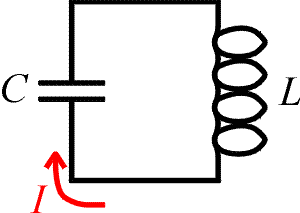|
LC circuits
The parameters that determine the motion of a spring are the mass m, spring constant k, the position x, and the velocity v which is the rate of change of x. The parameters that determine the behavior of an LC circuit are L, C, Q and I which is the rate of change of x. Thus there is a one-to-one correspondence since the equations of motion are identical given the substitutions:
The characteristic frequency of and LC circuit is the frequency at which large amplitudes are built up when a driving force comes in at that frequency. A child on a swing will be sensitive to a pushing force which comes regularly with the natural frequency of the swing. A force that comes at a different frequency will not build up a large amplitude as it will often be pushing against the child's motion. We call this the resonant frequency. |








 An LC
circuit is simply a closed loop with only two elements, a
capacitor and an inductor. We will show that the LC
circuits have resonant properties - they respond to
certain frequencies. Therefore they serve as the basis
for any device that needs to tune to a specific frequency
such as a radio. In an LC loop the charge oscillates back
and forth through the capacitor with a given frequency
just as a mass on a spring oscillates. To demonstrate the
equivalence, we list several equations for both a
mechanical spring and for an LC circuit.
An LC
circuit is simply a closed loop with only two elements, a
capacitor and an inductor. We will show that the LC
circuits have resonant properties - they respond to
certain frequencies. Therefore they serve as the basis
for any device that needs to tune to a specific frequency
such as a radio. In an LC loop the charge oscillates back
and forth through the capacitor with a given frequency
just as a mass on a spring oscillates. To demonstrate the
equivalence, we list several equations for both a
mechanical spring and for an LC circuit.







